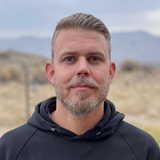What I’ve Learned From Headstones

I was listening to Mike Rowe’s podcast, “The Way I Heard It” and he made a comment in discussing Memorial Day that grabbed my attention. They were discussing Arlington National Cemetery and (I am paraphrasing here) he mentioned that the remarkable thing about Arlington is that in death, the American soldier lies side by side regardless of rank, race, or creed.
I visited Arlington in 2004 as a college student and watched a Marine promotion ceremony take place in the shadow of the Iwo Jima Memorial just outside Section 27 of Arlington. At the time, our Marines were fighting an insurgency in Iraq and would soon be in the Second Battle of Fallujah, and more names were being added to the list of those who had paid the ultimate sacrifice in service to our nation.
What I did not know at the time, is the history of the grounds I was walking on or the fact that African American troops were laid to rest just a few yards from where I stood in what was a segregated cemetery until 1948. I didn’t know at the time that the original land was owned and designated by George Washington’s adopted grandson or that this grandson’s son-in-law, Robert E. Lee was the executor of his estate until the Federal government seized the land for its strategic position for city defenses during the War between the States.
Arlington National Cemetery is over 600 acres of manicured grounds and undulating landscapes dotted with marble markers 4 inches deep, 13 inches wide, and 42 inches high, standing like homogeneous strata in 3D along the Potomac though the record of its interned more closely mirrors the social and racial strata of a conflicted nation. It is a singular monument to history, to the slave and to the freedman, to presidents and to the Unknown.
Originally segregated by race, military rank, and status, the cemetery in later years became, in some sense, a marker of what America aspired to be. Generals were interned alongside Privates and people of all races and backgrounds lay side by side for eternity. Death is the singular equalizer in an otherwise fallen world of racial tension, economic inequality, and “accidents of birth”.
This past weekend I watched “Taking Chance” as I always do on Memorial Day weekend. I woke up early Monday morning and went and participated in the Murph Challenge with my friend, Patrick, and later spent some time with family in gratitude for what so many have done to give me that privilege. But it was only later in the week after listening to Mike, that my thoughts on death and loss took a more general scope.
We so often categorize people by culturally or historically assigned values. Titles and salaries, family lineage, and politics sort people in neatly arranged pigeon holes. The magnetism of celebrity and power is the global drug of choice spurred on by the shortcuts of internet fame and violent infamy. Nearly everyone it seems is scratching tooth and claw for a seat at that table in a great race to outrun the great equalizer, death.
Those headstones, in addition to being monuments to the individuals and their sacrifice, are a reminder that in death we all face the same eternity, the same sorting in judgment, and the same God. We stand equal before our Creator and no title, no lineage and no great deed is enough to give us entrance into that final rest. We stand only on the sacrifice of Christ on the cross and nothing else.
In the end, the only legacy that matters is preparation for and living with eternity in view.





